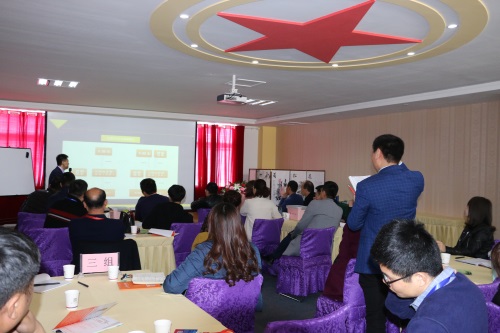頂層架構(gòu)設(shè)計(jì)是指在軟件開發(fā)或系統(tǒng)設(shè)計(jì)中,,對整個系統(tǒng)進(jìn)行整體規(guī)劃和設(shè)計(jì)的過程,。與其他層次的架構(gòu)設(shè)計(jì)相比,,頂層架構(gòu)設(shè)計(jì)具有以下特點(diǎn)和區(qū)別:
Top-level architecture design refers to the process of overall planning and design of the entire system in software development or system design. Compared with other levels of architecture design, top-level architecture design has the following characteristics and differences:
綜合性和整體性:
山東頂層架構(gòu)設(shè)計(jì)關(guān)注整個系統(tǒng)的綜合性和整體性,。它涉及到系統(tǒng)的總體結(jié)構(gòu),、組件之間的關(guān)系、數(shù)據(jù)流動和交互等方面,,以確保系統(tǒng)能夠滿足整體需求和目標(biāo),。
Comprehensiveness and integrity: The top-level architecture design in Shandong focuses on the comprehensiveness and integrity of the entire system. It involves the overall structure of the system, the relationships between components, data flow, and interaction to ensure that the system can meet overall requirements and goals.
概念層次和抽象層次:頂層架構(gòu)設(shè)計(jì)通常處于較高的概念層次和抽象層次。它關(guān)注系統(tǒng)的核心功能和關(guān)鍵問題,,而不涉及具體實(shí)現(xiàn)和細(xì)節(jié)設(shè)計(jì),。它為后續(xù)的詳細(xì)設(shè)計(jì)提供指導(dǎo)和約束。
Conceptual level and abstract level: The top-level architecture design is usually at a higher conceptual level and abstract level. It focuses on the core functions and key issues of the system, without involving specific implementation and detailed design. It provides guidance and constraints for subsequent detailed design.
決策和風(fēng)險(xiǎn)管理:頂層架構(gòu)設(shè)計(jì)需要考慮各種決策和風(fēng)險(xiǎn)管理,。比如,,選擇適當(dāng)?shù)募夹g(shù)平臺和框架、確定系統(tǒng)的可擴(kuò)展性和可維護(hù)性,、評估和解決潛在的風(fēng)險(xiǎn)等,。這些決策和管理對系統(tǒng)的長期發(fā)展和成功至關(guān)重要。
Decision making and risk management: The top-level architecture design needs to consider various decisions and risk management. For example, selecting appropriate technology platforms and frameworks, determining the scalability and maintainability of the system, evaluating and addressing potential risks, etc. These decisions and management are crucial for the long-term development and success of the system.

需求和業(yè)務(wù)導(dǎo)向:頂層架構(gòu)設(shè)計(jì)應(yīng)該緊密關(guān)聯(lián)系統(tǒng)的需求和業(yè)務(wù)目標(biāo),。它應(yīng)該與業(yè)務(wù)需求對齊,,并確保系統(tǒng)具備滿足業(yè)務(wù)需求的能力。在設(shè)計(jì)過程中,,需求分析和業(yè)務(wù)理解是非常重要的,。
Requirements and business orientation: The top-level architecture design should be closely related to the system's requirements and business objectives. It should be aligned with business requirements and ensure that the system has the ability to meet business requirements. Requirements analysis and business understanding are crucial in the design process.
其他層次的架構(gòu)設(shè)計(jì)則更關(guān)注于系統(tǒng)的特定方面和細(xì)節(jié),如模塊化設(shè)計(jì),、數(shù)據(jù)架構(gòu)設(shè)計(jì),、安全架構(gòu)設(shè)計(jì)等。這些設(shè)計(jì)通?;陧攲蛹軜?gòu)設(shè)計(jì)的指導(dǎo)和約束,,負(fù)責(zé)系統(tǒng)的具體實(shí)現(xiàn)和技術(shù)細(xì)節(jié)。
Other levels of architecture design focus more on specific aspects and details of the system, such as modular design, data architecture design, security architecture design, etc. These designs are usually based on the guidance and constraints of top-level architecture design, responsible for the specific implementation and technical details of the system.
頂層架構(gòu)設(shè)計(jì)是系統(tǒng)設(shè)計(jì)過程中的首要步驟,,它確定了系統(tǒng)的整體結(jié)構(gòu)和核心問題的解決方案,。其他層次的架構(gòu)設(shè)計(jì)則進(jìn)一步深入到系統(tǒng)的具體細(xì)節(jié)和子系統(tǒng),以實(shí)現(xiàn)頂層設(shè)計(jì)的目標(biāo)和要求,。
The top-level architecture design is the first step in the system design process, which determines the overall structure of the system and the solutions to core problems. The architecture design at other levels further delves into the specific details and subsystems of the system to achieve the goals and requirements of the top-level design.
兩者相輔相成,,共同構(gòu)建出一個穩(wěn)健、可擴(kuò)展和符合需求的系統(tǒng),。更多相關(guān)事項(xiàng)就來我們網(wǎng)站
http://nequ.com.cn進(jìn)行咨詢了解吧,!
The two complement each other and work together to build a robust, scalable, and compliant system. For more related matters, come to our website http://nequ.com.cn Consult and learn more!



 13698613138
13698613138


